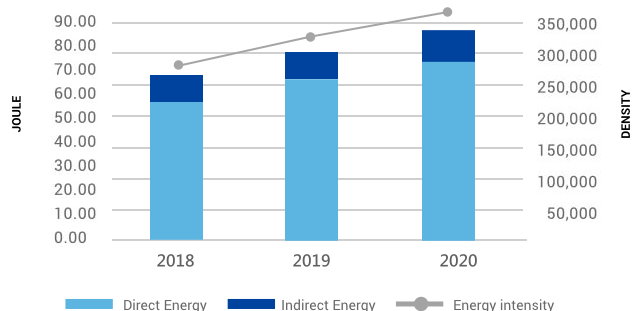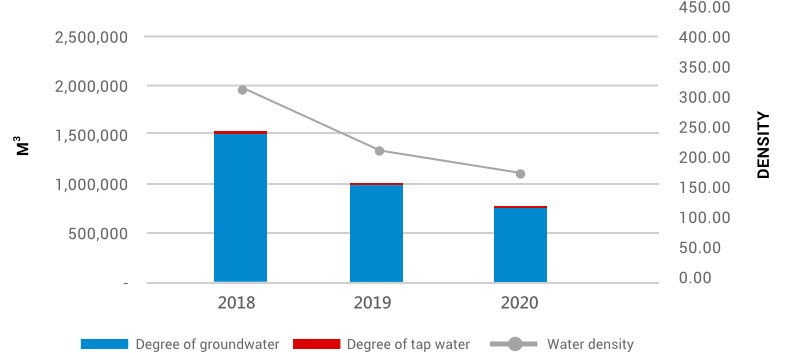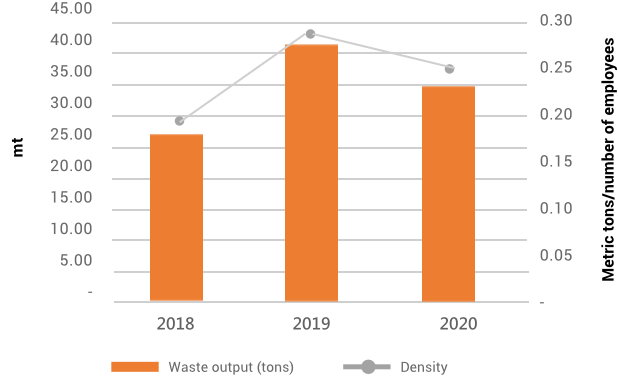
Corporation Social Responsibility
Fulfill carbon reduction, build green homes, emphasize environmental education
Green Promise
Environmental sustainability is the company's green commitment to the environment. We follow the development strategy of "implementing energy conservation and carbon reduction, creating green homes, and strengthening ecological education" to achieve environmental sustainability, and we obtain from raw materials, manufacturing, transportation and distribution, and product use. We plan for each stage of the product life cycle, including final disposal, and set environmental sustainability short, medium and long-term development goals, and specifically incorporate energy conservation, carbon reduction, and environmental protection issues into our business plans, and formulate the company's internal environmental code of conduct.
Energy Consumtion and Density in the recent 3 years

Energy management
Energy consumption is the main factor contributing to climate change, because burning non-renewable fuels produces greenhouse gases (GHG) and causes other environmental impacts. With the steady growth of the company's operations, we have taken a cautious attitude to improve the efficiency of various types of energy use, control greenhouse gas emissions, effectively reduce the intensity of per capita energy consumption, and avoid the increase in the use of oil and electricity.
(1) Direct energy: The fuel consumption in 2020 was 7,385 kilograms or 284,459 G Joules, an increase of approximately 9.18% compared to 6,764 kilograms in 2019.
(2) Indirect energy: The consumption of indirect energy (power consumption) in 2020 was 15,469,582 kWh or 55,690 G Joules, an increase of 8.68% from the 2019 consumption of 14,233,820 kWh.
(3) Total energy consumption: total energy consumption in 2020 was 340,149 G Joules, an increase of approximately 9.01% compared to 2019 energy consumption. The energy consumption intensity in 2020 was 84.32 GJ/million yuan, an increase of approximately 17.45% compared to the energy consumption intensity in 2019.
Water resources management and waste water treatment
The company's Suao Plant still uses groundwater for its production process. Although Yilan has abundant groundwater resources, the Suao Plant still actively saves and makes good use of water resources. In addition to setting up a cooling water recovery system, the non-contact cooling water in the process is recovered and cooled for reuse, and the process is actively evaluated to improve and reduce the water consumption of the process. Make good use of recycled cooling water for spraying water on storage yards, roads, turf and green plants, in order to use water resources for multiple purposes. The company's water consumption statistics and waste water treatment methods are as follows:
2020 Water consumption statistics and waste water treatment list
| Location | Non-process water(Tap water) | Process water (groundwater) | Waste water treatment method |
|---|---|---|---|
| Headquarter | 1.800M3 | - | General domestic sewage is included in the sewage sewer system. |
| Suao Main Factory | - | The process is used to produce hydrochloric acid water; estimated according to the output: 897,000 tons | D-01 discharge port: 230M3 D-01 is directly discharged to Xincheng Creek to connect to the sea D-02 discharge port: 386,830 M3 D-02 is a row of farmland water conservancy rows The above discharges are in compliance with wastewater discharge standards, and there is no leakage that affects the ecological environment. |
| Changhua Factory | 490M3 | - | General domestic waste water is treated in a unified manner by the waste water treatment plant in the industrial zone. |
| Taichung Factory | 336M3 | - | General domestic waste water is included in the sewage plant of the industrial zone for unified treatment. |
Water consumption and intensity in the past three years

▲Total water consumption: The total energy consumption in 2020 was 90 million tons, which is about 11.03% less than the energy consumption in 2019. The water consumption intensity in 2020 was 223.1 M3/million yuan, which was about 3.04% less than the energy consumption intensity in 2019. The main reason is that the process water recovery system has been completed and strengthened, and the complete recovery of process water is the ultimate goal.
Waste management
The company's waste source management operation method divides the sources into two categories: employee domestic waste and business waste; domestic waste management improves employee behavior through employee education and training to effectively promote reduction and classified management, and improve resource re-utilization and the value of resource regeneration; the management of industrial waste is to reduce management by simplifying packaging materials, reducing the proportion of hazardous waste, and recycling and reusing resources.
In accordance with the regulations of the Waste Disposal Law, the Suao factory wastes are stored and classified during collection to maximize the completeness of waste classification. Each unit concentrates the waste in the storage place, and has dedicated personnel for management and planning of waste disposal. The reduction and entry and exit control of materials, and the treatment process are in compliance with environmental protection regulations.
The total amount and intensity of waste in
the past three years

Total waste: The total amount of domestic waste in 2020 was 35.28 metric tons, an increase of about 14.6% compared to the total amount of waste in 2019. The waste intensity in 2020 was 0.21 metric tons/person, an increase of about 20% compared to the energy consumption intensity in 2019, and the difference between the two years was not significant.
Greenhouse gas management
The increase in greenhouse gas emissions has led to climate change, which not only directly impacts the global ecological environment, but also indirectly affects the acquisition of corporate resources. It has become an environmental issue of global concern and attention. In order to fulfill its corporate responsibilities, the company identifies sources of greenhouse gas emissions, uses energy-saving and emission reduction methods to reduce greenhouse gas emissions, improves its own management capabilities, replaces high-energy-consumption process equipment, and discusses greenhouse gas reduction programs to jointly achieve low actively work hard for a sustainable carbon home.
| 2020 Statistics on greenhouse gas emissions | |||
|---|---|---|---|
| Category/emission intensity | Type of emission source | Usage amount | Emissions |
| Category 1 | Fuel usage | 7,377 kL | 22,950 tonCO2e |
| Diesel usage | 22.27 kL | 58.02 tonCO2e | |
| Category 2 | Electricity usage | 15,470 MWh | 8,073 tonCO2e |
| Greenhouse gas emission intensity | Category 1+Category 2 | 7.7 tonCO2e/million dollar | |
▲Coefficient and calculation source:
(1) Greenhouse gas emission coefficient management table 6.0.3 version recommended emission coefficient, diesel emissions 2.6060 KgCO2/L, fuel oil emissions 3.111 KgCO2/L.
(2) Calculated based on the revenue of 4,034 million yuan in the 2020 financial report.
Environmental protection cost and energy saving and carbon reduction
In order to reduce the impact of the production process on the environment, improve product competitiveness, and fulfill corporate social responsibilities, the company clearly classifies and controls various environmental protection expenditures, which helps to evaluate the implementation efficiency of environmental protection measures and Internal cost-benefit analysis, the environmental protection input cost in 2020 is 99,571 thousand TWD, the details are as follows:
| Project | 2019 | 2020 |
|---|---|---|
| Total investment of newly purchased fixed equipment and plant | 78,750 | 81,400 |
| Amount of newly purchased pollution prevention equipment | 2,250 | 2,240 |
| Air pollution control | 6,080 | 6,850 |
| Water pollution prevention | 1,420 | 1,562 |
| Waste disposal | 3,500 | 4,200 |
| Noise and vibration control | 2,305 | 2,305 |
| Fixed source air pollution prevention and control fee | 838 | 1,014 |
| Total | 95,143 | 99,571 |




